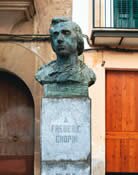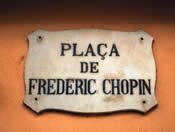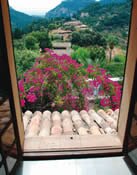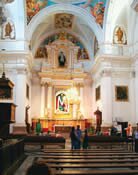Inflight Magazine of Brussels Airlines
Welcome to the Inflight Magazine of Brussels Airlines
Piano man
Mallorca was a safe haven for the high and mighty long before Catherine Zeta-Jones and Michael Douglas dropped anchor. As Adrian Mourby discovers, this island hideaway was where Chopin, the great piano composer whose bicentenary falls this year, wrote some of his best-known masterpieces
 Ateenager gets up from the bench on which she’s been sitting with some friends outside the Real Cartuja – the stone monastery that dominates the small, pleasant town of Valldemossa, shoehorned into one of Mallorca’s northern valleys. As the girl and her friends move on, she lets a hand trail idly over a grey metal bust that faces mournfully away from the Real Cartuja. Inevitably, she rubs the aquiline nose, which gleams in the midday sun. It is a very prominent nose. The girl doesn’t pause to wonder whose face she’s massaging for luck. People have been rubbing this nose for decades – and its owner would be mortified. For Frédéric Chopin was not only a most private man, but he was also very self-conscious about his nose. Nor did the composer find his time in Valldemossa easy – but then, he found life in general difficult.
Ateenager gets up from the bench on which she’s been sitting with some friends outside the Real Cartuja – the stone monastery that dominates the small, pleasant town of Valldemossa, shoehorned into one of Mallorca’s northern valleys. As the girl and her friends move on, she lets a hand trail idly over a grey metal bust that faces mournfully away from the Real Cartuja. Inevitably, she rubs the aquiline nose, which gleams in the midday sun. It is a very prominent nose. The girl doesn’t pause to wonder whose face she’s massaging for luck. People have been rubbing this nose for decades – and its owner would be mortified. For Frédéric Chopin was not only a most private man, but he was also very self-conscious about his nose. Nor did the composer find his time in Valldemossa easy – but then, he found life in general difficult.
How one of the greatest pianist-composers of the 19th century came to be on Mallorca in 1838 is a curious story, although this corner of the island seems to attract celebrities in search of a quieter life. Robert Graves bought a house near Valldemossa, in which he wrote I, Claudius; Andrew Lloyd-Webber and Tim Rice stayed not far from here while planning Evita; and Michael Douglas and Catherine Zeta-Jones currently keep a holiday home a few kilometres out of town, on the coast. Still, Chopin was the first star name to cross the Mediterranean in search of island peace and inspiration.
 The idea of visiting Mallorca was not the composer’s own, though; his mistress George Sand suggested it. In the 1830s, the flamboyant Sand was as well-known as her reclusive lover. The French novelist dressed in men’s clothes, smoked in public and had already taken six lovers since separating from her husband, without making much effort to be discreet. Chopin had met Sand in Paris, where he gave piano lessons to aristocratic patrons. At first repelled, he later succumbed to Sand’s desire and devotion. Nevertheless, he was uncomfortable with their relationship being talked about in public, so Sand proposed they spend the winter of 1838 in Mallorca, away from Parisian gossip and in a climate warm enough to help the composer’s fragile health.
The idea of visiting Mallorca was not the composer’s own, though; his mistress George Sand suggested it. In the 1830s, the flamboyant Sand was as well-known as her reclusive lover. The French novelist dressed in men’s clothes, smoked in public and had already taken six lovers since separating from her husband, without making much effort to be discreet. Chopin had met Sand in Paris, where he gave piano lessons to aristocratic patrons. At first repelled, he later succumbed to Sand’s desire and devotion. Nevertheless, he was uncomfortable with their relationship being talked about in public, so Sand proposed they spend the winter of 1838 in Mallorca, away from Parisian gossip and in a climate warm enough to help the composer’s fragile health.
Valldemossa on a sunny day seems the ideal place to hide away from a European winter. The monastery’s spacious cells look out on to a valley lush with poplars and dotted by the pan-tiled roofs of farm buildings, with palms for shade and bougainvillea for colour. Locals disagree as to which cell was actually Chopin’s. When the monastery was appropriated by the state in 1835, various families bought up the cells that had hitherto been occupied by Carthusian monks. George Sand rented two – one for Chopin and the other for herself and her two children – but as no record of cell numbers was kept, cells two and four both claim that Chopin composed many of his best-loved pieces within their walls. Today, tourists go from one to the other. Both have pianos that are said to have belonged to the composer, which is just about possible, as Chopin rented a local piano until a Pleyel (his preferred type of instrument) was delivered from Paris. The Chopin Institute in Warsaw questions the authenticity of both pianos, however, not least because the composer was believed to be suffering from tuberculosis when on Mallorca; furniture belonging to a consumptive was always burned when the islanders could get their hands on it.
 Bad health dogged Chopin, which may explain his sensitive nature. Certainly he was very happy to let George Sand take care of all practical arrangements, while he wrote music or just read. The story of their time on Mallorca is hardly one of the devoted muse nurturing her genius composer, however, as the idyll soon turned sour. Sand’s reputation, as not only a writer but also a proto-feminist, preceded her in Palma de Mallorca, where the couple first took an apartment (in Calle Puigdorfila), and the local aristocracy kept their distance. (Nowadays, people are much more comfortable with Chopin’s presence in Palma, and the couple’s sojourn is commemorated by another Chopin bust in the nearby Plaza de Frédéric Chopin.)
Bad health dogged Chopin, which may explain his sensitive nature. Certainly he was very happy to let George Sand take care of all practical arrangements, while he wrote music or just read. The story of their time on Mallorca is hardly one of the devoted muse nurturing her genius composer, however, as the idyll soon turned sour. Sand’s reputation, as not only a writer but also a proto-feminist, preceded her in Palma de Mallorca, where the couple first took an apartment (in Calle Puigdorfila), and the local aristocracy kept their distance. (Nowadays, people are much more comfortable with Chopin’s presence in Palma, and the couple’s sojourn is commemorated by another Chopin bust in the nearby Plaza de Frédéric Chopin.)
Sand’s smoking and wearing of men’s clothing made her an alarming, eccentric figure, and she later complained (in her 1855 memoir Un Hiver à Majorque, ‘A Winter in Mallorca’) that local families shunned them – but then, she had arrived with unrealistic expectations of being lionised, as she was in Paris. “There is a general ignorance of fashion,” she wrote of Palma’s aristocracy. “[They are] hedged in by their own apathy. Hence hospitality is in practice limited to courteous phrases.” When a marquis gallantly told Sand that his carriage was always at her disposal, she took him at his word and made off with it, causing a scandal. Not sending her children to Mass was the last straw.
Nevertheless, Chopin seemed to be enjoying the city, as his letters show: “I am in Palma, surrounded by palm trees, cedars, olive trees, orange trees and lemon trees, aloes and fig trees and pomegranates, etc. Everything that the botanical gardens have growing in their hothouses. A turquoise sky, emerald mountains and the air from paradise. The sun shines all day long, people are dressed as though this were the summer and it is hot; at night guitars and singing can be heard for hours on end.”
Unfortunately, the noise of coopers hammering (they were in an industrial part of the city) and a lack of furniture for rent necessitated a move if Chopin was ever to compose in comfort. Sand relocated their ménage to ‘Son Vent’, a furnished villa in Establiments on the outskirts of Palma. She soon fell out with the owner, however, and after a few weeks they decamped to the recently emptied monastery in Valldemossa.
 Here, Sand considered the locals positively hostile, describing them as ignorant, superstitious, unfriendly, untrustworthy and living in squalor.
Here, Sand considered the locals positively hostile, describing them as ignorant, superstitious, unfriendly, untrustworthy and living in squalor.
She even called them “monkeys”. But for Chopin, Valldemossa represented a level of tranquillity hitherto absent from his life, saying: “Tonight the moon is marvellous. Never have I seen it like this. The poetry which everything here exhales and the colouring of this most marvellous scenery still untainted by the eye of man.”
In fact, during their five months at the Real Cartuja it wasn’t the island, but his relationship with Sand, that Chopin developed serious doubts about. He decided to return to the Catholic communion and renounced their sexual relationship – although he was willing to continue living with her and have her take care of his day-to-day needs.
Bearing this situation in mind, then, it’s perhaps not surprising that Sand looked for a scapegoat for her unhappiness, and blamed the Mallorcans. The couple left the island earlier than they had intended, in February 1839, sailing on a French ship, much to Sand’s relief: “When we boarded this fine brig, as clean and elegantly kept as a drawing room, we jumped for joy on the bridge and cried from the bottom of our hearts. Vive la France!”
Today, however, many people consider those difficult five months on the island to be Chopin’s most productive period. Back in Paris, on 26 April 1841, he played many of the works he’d composed in Valldemossa. The private recital, which included what are now some of his best-known nocturnes, etudes and polonaises, was a huge success. And what’s also curious is that among all the postcards and CDs on sale in the monastery of Valldemossa today you’ll find, in pride of place, George Sand’s blistering attack on Mallorca. The islanders actually keep it in print, which shows their sense of humour – and that they clearly bear no resentment towards their first celebrity visitors.
Hear all about it
Visit one of this year’s Chopin festivals
Mallorca
The Chopin Festival, Valldemossa
Held annually over weekends in August, this festival uses the cloisters adjoining Chopin’s cell as a venue. The first concert in 2010 will be on 1 August and will feature pianist Ivan Martin with the Balearic Islands Symphony Orchestra. www.festivalchopin.com
Warsaw
Chopin’s Year at the Warsaw Philharmonic
The Warsaw Philharmonic began its year-long celebration of the composer’s music on 7 January. Featured artists will include pianists Lang Lang and Julia Kociuban, soprano Joanna Kozłowska, conductor Antoni Wit and the winner of the 2010 National Chopin Piano Competition. There will also be a series of talks by the Fryderyk Chopin Institute. www.chopin2010.pl
London
Chopin at 200: Celebrating a Musical Imagination
In 1848 Chopin left Paris for London, where he gave a number of concerts in great houses. He visited Scotland and then returned to London for his last public concert at the Guildhall. This year, the Southbank Centre hosts a sequence of Chopin concerts at the Royal Festival Hall, Queen Elizabeth Hall and Purcell Room, plus pre–concert talks focusing on Chopin as a musical innovator. www.southbankcentre.co.uk
FR Le Pianiste
Adrian Mourby nous emmène dans la retraite de Chopin sur l’île de Majorque, où le grand pianiste dont le bicentenaire sera célébré cette année, a composé quelques-uns de ses plus grands chefs-d’oeuvre
C’est une bien curieuse histoire que celle qui a poussé l’un des plus grands pianistes compositeurs du 19e siècle à se rendre à Valldemossa, sur l’île de Majorque en 1838. L’idée de visiter Majorque n’était pas celle de Chopin, mais de sa maîtresse d’alors, George Sand, rencontrée à Paris. C’est elle qui avait suggéré ce voyage. En effet, Chopin n’était pas très à l’aise vis-à-vis de leur relation qui faisait jaser. Sand proposa donc qu’ils passent l’hiver de 1838 à Majorque, loin des ragots parisiens et dans un climat suffisamment clément pour la santé fragile du compositeur.
Bien qu’au début le couple séjourna dans une auberge de fortune à Palma (dans la Calle Puigdorfila), il posa ensuite ses valises au Real Cartuja, un ancien monastère de Valldemossa, lieu idéal pour se mettre à l’abri de l’hiver européen. Les cellules spacieuses de la Chartreuse donnent sur une vallée verdoyante, plantée de peupliers et parsemée des toits en tuiles rouges des corps de fermes. On y trouve également des palmiers pour l’ombre et des bougainvillées pour la couleur.
Valldemossa apportait à Chopin une quiétude jusque là absente de son existence. “La poésie que chaque chose ici exhale et la coloration de ce paysage merveilleux restent encore préservés des regards extérieurs,” écrit-il dans ses lettres.
Durant les cinq mois passés à la Chartreuse de Real Cartuja, Chopin commença à nourrir de sérieux doutes sur sa relation amoureuse avec Sand et il décida de mettre un terme à leur liaison. Il n’est donc pas étonnant que le couple quitta l’île plus tôt que prévu, en février 1839.
Aujourd’hui, nombreux sont ceux qui estiment que ces cinq mois passés sur l’île de Majorque constituent l’une des périodes les plus fécondes de Chopin, produisant ce que l’on considère à ce jour comme ses plus célèbres nocturnes, études et polonaises.
NL Pianist
Adrian Mourby onthult hoe het eiland Palma de Mallorca het verborgen plekje was waar Chopin, de geroemde pianocomponist van wie dit jaar het tweehonderdjarige jubileum gevierd wordt, enkele van zijn meest gekende meesterwerken schreef.
Hoe één van de grootste pianocomponisten van de 19de eeuw in 1838 in Valldemossa op het eiland Mallorca terechtkwam, is een merkwaardig verhaal. Het idee om Mallorca te bezoeken kwam niet van Chopin zelf, maar van George Sand, zijn toenmalige maîtresse die hij in Parijs had leren kennen. Omdat Chopin er zich ongemakkelijk bij voelde dat er in het openbaar over hun relatie geroddeld werd, stelde Sand voor dat ze de winter van 1838 in Mallorca zouden doorbrengen, ver weg van het Parijse geroddel en in een klimaat dat warm genoeg was om heilzaam te zijn voor de fragiele gezondheid van de componist.
Hoewel het koppel eerst op een appartement in Palma (in Calle Puigdorfila) verbleef, verhuisden ze uiteindelijk naar Real Cartuja, een voormalig klooster in Valldemossa, de ideale plaats om te schuilen voor de Europese winter. De ruime vertrekken van het klooster keken uit over een vallei waar populieren weelderig groeiden en waarin men de daken van de boerderijen als stipjes kon zien liggen, en er waren palmen die voor schaduw zorgden en bougainvilles (Zuid–Amerikaanse plant) die het geheel kleur gaven.
Voor Chopin vertegenwoordigde Valldemossa rust die tot dusver afwezig was geweest in zijn leven. “De poëzie die hier door alles wordt uitgeademd en de kleuren van het meest prachtige landschap zijn nog onaangetast door het menselijke oog,” schreef hij in zijn brieven.
Tijdens de vijf maanden waarin ze in Real Cartuja verbleven, begon Chopin ernstig te twijfelen aan zijn relatie met Sand en besliste hij om hun seksuele relatie op te geven. Het is dan waarschijnlijk niet verwonderlijk dat het koppel het eiland vroeger dan gepland verliet, in februari 1839.
Vandaag worden deze vijf maanden op het eiland Mallorca beschouwd als de meest productieve periode van Chopin, waarin hij enkele van wat nu zijn meest gekende nocturnes, etudes en polonaises neerpende.
Leave a Reply
